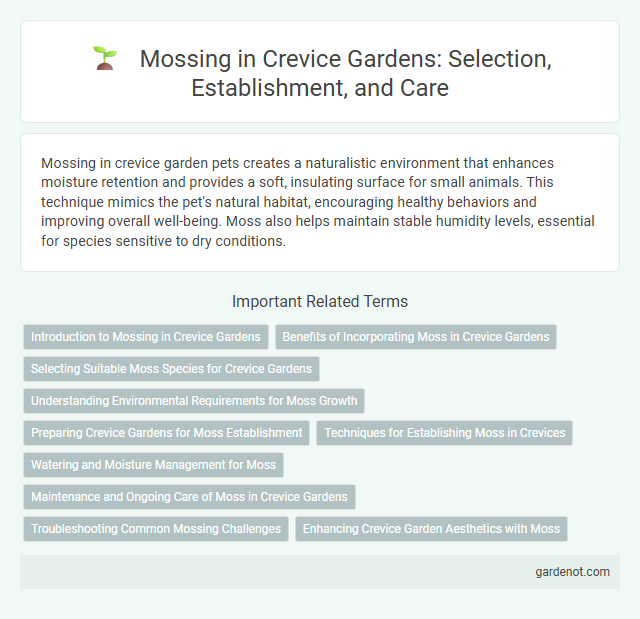Mossing in crevice garden pets creates a naturalistic environment that enhances moisture retention and provides a soft, insulating surface for small animals. This technique mimics the pet's natural habitat, encouraging healthy behaviors and improving overall well-being. Moss also helps maintain stable humidity levels, essential for species sensitive to dry conditions.
Introduction to Mossing in Crevice Gardens
Mossing in crevice gardens enhances moisture retention and adds an ancient, naturalistic aesthetic to stone arrangements. Moss thrives in the shaded, humid microclimates created by the narrow rock crevices and compact planting spaces. This low-maintenance ground cover supports biodiversity by providing habitat for small invertebrates and contributing to soil health.
Benefits of Incorporating Moss in Crevice Gardens
Incorporating moss in crevice gardens enhances moisture retention by absorbing and slowly releasing water, creating a stable microenvironment for surrounding plants. Moss aids in soil erosion control by binding loose soil and rock particles, maintaining structural integrity in rocky garden crevices. Its low-maintenance growth reduces the need for frequent watering and fertilization, promoting sustainable garden care.
Selecting Suitable Moss Species for Crevice Gardens
Selecting suitable moss species for crevice gardens involves identifying varieties that thrive in shaded, moist, and well-drained environments characteristic of narrow rock gaps. Species like Hypnum cupressiforme, Bryum capillare, and Polytrichum commune are ideal for their adaptability to crevices, resilience to drying, and ability to anchor firmly on rocky surfaces. Ensuring proper microclimate conditions and substrate compatibility enhances moss establishment and longevity in crevice garden settings.
Understanding Environmental Requirements for Moss Growth
Moss growth in crevice gardens thrives in shaded, moist environments with high humidity and consistently damp substrates. Optimal conditions include acidic to neutral pH levels between 5.0 and 6.0, low nutrient availability, and stable temperatures ranging from 15degC to 25degC. Proper site selection and microhabitat management ensure successful moss establishment and sustained coverage in crevices.
Preparing Crevice Gardens for Moss Establishment
Preparing crevice gardens for moss establishment requires selecting shaded, moist locations with acidic, well-drained substrates rich in organic matter. Surface preparation involves cleaning rocks and compacting soil to create stable niches where moss spores can anchor effectively. Regular misting and maintaining consistent humidity accelerate moss colonization and ensure healthy growth in these specialized garden settings.
Techniques for Establishing Moss in Crevices
Techniques for establishing moss in crevices emphasize selecting shaded, moist locations to mimic natural habitats and using fine-textured moss species that thrive in limited soil. Preparing the surface by clearing debris and lightly roughening rock or concrete enhances moss adhesion and growth. Frequent misting and maintaining consistent moisture levels during the initial establishment period significantly improve moss rooting and coverage.
Watering and Moisture Management for Moss
Proper watering and moisture management are crucial for maintaining healthy moss in a crevice garden. Moss thrives in consistently moist environments, requiring gentle and frequent watering to prevent drying out without causing waterlogging. Employing a fine mist spray ensures even moisture distribution, promoting lush growth while avoiding excess runoff or soil erosion.
Maintenance and Ongoing Care of Moss in Crevice Gardens
Moss in crevice gardens requires consistent moisture and indirect sunlight to thrive, with regular misting helping maintain optimal humidity levels. Regular removal of debris and occasional gentle pruning prevent moss overgrowth and ensure healthy propagation. Monitoring soil pH and maintaining slightly acidic conditions between 5.0 and 6.5 supports vibrant moss coloration and longevity.
Troubleshooting Common Mossing Challenges
Mossing in crevice gardens often faces challenges such as poor moisture retention and insufficient shade, which hinder moss growth. To troubleshoot these issues, maintain consistent humidity levels by watering gently and ensure the garden is positioned in a shaded or partially shaded area. Regularly remove debris and manage competing plants to prevent moss from being overtaken and allow healthy moss colonization.
Enhancing Crevice Garden Aesthetics with Moss
Mossing enhances crevice garden aesthetics by creating a lush, green tapestry that softens the rugged stone textures and fills narrow gaps naturally. The moisture-retentive quality of moss supports micro-ecosystem diversity, encouraging small ferns, lichens, and other shade-loving plants. Integrating mosses not only improves visual appeal but also stabilizes soil within crevices, reducing erosion and promoting long-term garden health.
Mossing Infographic

 gardenot.com
gardenot.com